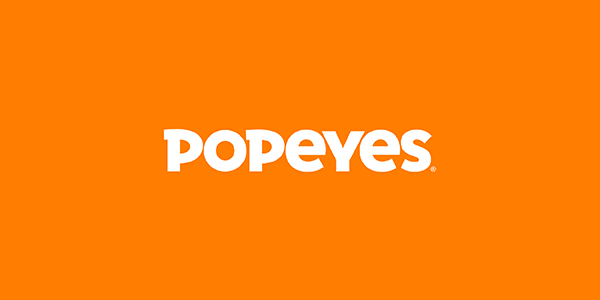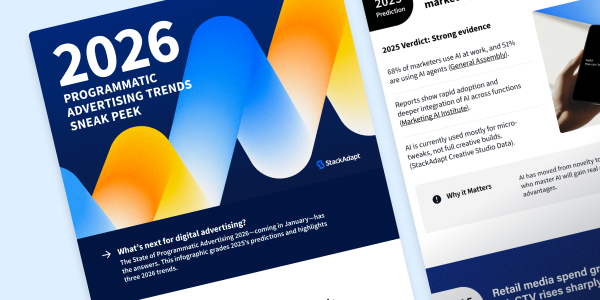How Agencies Thrive: S3
Episode 4
Global Trends in Advertising Spend

About This Episode
We unpack global marketing and advertising trends, including insights in agency spending and consumer behaviour in markets around the globe.
Karan Saggi and Samantha Allison | Directors of Client Services at StackAdapt
Louise Hutley | Senior Manager, Client Services at StackAdapt
Transcript
Episode Introduction (00:00:00)
Inflation is pinching everyone. People want value for their money. And so it’s important that with every odd, we’re able to get in front of the right people at the right time when they’re ready is purchasing, market customization is definitely a trend that we’ve seen, you know, contextually relevant or relevant in whatever capacity that is to the user, things are always changing. And with the current market, we need to make sure that is at the forefront.
How Agencies Thrive Introduction (00:00:23)
But then you think about the social landscape, the research and data is hugely significant when we combine all of these different touch points, so that long-term loyalty and then diving into the clicks to leads to sales, gotten to a point where it can drive better results in audience targeting, and really is what’s going to set you apart. You’re tuning in, you’re tuning in, or tuning in to the How Agencies Thrive podcast.
Matt (00:00:48)
Hi everyone, and welcome to this episode of The How Agencies Thrive podcast. This week, our topic of choice is an inside look at ad spend around the globe, and more specifically in North America, EMEA and APAC region. In this episode, we’re going to be doing a special roundtable with experts from StackAdapt. On deck, we have Karan Saggi, from North America, Sam Allison, from EMEA and Louise Hutley from the APAC region. We’re going to look at programmatic budgets, consumer behaviour, buying signals, trends, and everything else that’s going on around the globe in advertising. So as always, before we get started, I’d love to hear from our guests to talk a little bit about their role, their experience and areas of expertise that they have in the programmatic space. So let’s get started with you, Karan, tell us a little bit about yourself and your experience in programmatic.
Karan (00:01:39)
Thanks, Matt. Everyone, this is Karan. I’m a manager of Client Services at StackAdapt. I’ve been at the company for about two years, been in programmatic for about six years. Really happy to be here to chat with you about the North American market.
Sam (00:01:55)
Yeah, my name is Sam. I’m also a manager of Client Services, based out of EMEA. I’ve been with StackAdapt for about three and a half years now. I actually started off in North America, and in January of 2021, moved over to London, to kind of kickstart the expansion of StackAdapt within EMEA.
Louise (00:02:19)
Cool, and my name is Louise, I am also a manager of Client Services for the APAC region. I’ve been with StackAdapt for around five months now. So I’m the newest member to the team here. Previous to that I worked in agency holding groups in a digital capacity for about 12 years now. I think my experience with programmatic dates back to 2011, when programmatic was officially the buzzword, whilst I was working in the London office, so excited to still be part of that journey.
Matt (00:02:50)
Perfect. Well, what we’ll do for this episode, as I mentioned, we’re chatting ahead of time, we have a couple questions, you know, talking about budgets, consumer behaviour, all things programmatic across the globe. So what we’ll do is we’ll start with those first two questions, take a quick break, and then jump into the latter portion of the episode. So starting out, we’ll pass things around the table here. What is the current spend in each of your regions? So EMEA, APAC, North America, you know, where’s the money going in the programmatic space? And what are we seeing some trends in?
Karan (00:03:26)
Great question, Matt, I can kick this off for the North American market. Looking at programmatic specifically, the ad spend last year in 2021, was approximately $158 billion. This is specifically for display and video formats. Display took a larger piece of the pie there, with about $106 billion of the $158. And the remaining going to video that ad spend is actually forecast to grow year over year as it has over the past few years. The entire size of the pie is forecast to grow, from about $158 billion to $196 billion this year. And 2022 of that $196 billion displays forecast to grow at 22% year-over-year and video to grow a little bit more aggressively at 28%. Again, this is strictly looking at programmatic. If we zoom out a bit and look at overall digital, we’re looking at even higher spend levels. That’s about $249 billion. Because we’re now factoring in search primarily, that also pulls in significant investment in addition to display and video. And if you look at what industries are investing here this year, it’s mostly retail, CPG, and consumer products in the North American market, and which is why the upcoming holiday season should be quite interesting this year.
Louise (00:04:56)
Yeah, it’s a similar story in APAC. 2022 ad spend is forecast to reach around $250 billion. That numbers in USD up 5%, from 2021. With digital inevitably fueling much of this growth, the spotlight is really on India, with some recent estimates expecting 16% growth in this market alone. And a lot of that is coming from emerging industries such as ad tech, FinTech, gaming and crypto as well as key sporting events and some general elections that we’ve had in a couple of the APAC markets. Similar to the US, we’re seeing an increase in time spent online, particularly video consumption, which grew significantly over COVID. We’re also experiencing inflation, which means the same dollar investments aren’t going as far. And despite this, we expect video to continue to gain momentum across the region. However, the measurement challenge needs to be better addressed to justify the investment, particularly in non-clickable environments, such as connected TV, if it is able to take a chunk out of the significant linear TV spend, we continue to see in the APAC region.
Sam (00:06:05)
Yeah, and then just shifting over to EMEA we’re actually seeing slightly lower than other markets in terms of spend. So we’re seeing anywhere when looking at programmatic from above that 75 to 80 billion mark, the leader in that spend actually does come from the United Kingdom followed would be Germany, France, and Italy, who have the highest ad spend within that region. I think a key consideration here is to know where the majority of that spend is coming from. And right now, we’re seeing about 60% of that spend coming from mobile, across various channels like display and video, but using mobile as the primary driver of the inventory source. And then very similar to the other two markets, actually, we are seeing an increase within video. In a post-COVID world, we’re also seeing, you know, the travel vertical increase, but specifically marrying the two both travel and video, within EMEA, we are it is projected to see that the video spend within travel goes up by about three times in 2022. Within EMEA, one of the things that’s consistently at the forefront of every conversation is GDPR. I would say that’s the biggest point of difference when comparing to other markets. Obviously, you know, privacy and data and all that is very important in the other markets as well. But within EMEA, it very much is under a microscope of consumers understanding how and why the data is collected. But not only that, they’re very interested in the quality of inventory and where that ad is exactly being placed. So I think that’s a major factor as well, when considering, you know, ad spend and projections and all that kind of thing.
Matt (00:07:51)
Fantastic. Well, this is definitely taught me a lot already at the beginning of this episode. I mean, when Sam, you and I started working at StackAdapt, a couple of years ago, we were really only working in the North American market. And then there was buzz about GDPR. So it’s interesting to see how big of an impact it still has. But you know, with all this in mind, you know, understanding where the spend is going some of these channels and verticals. I’m interested to know from all of you when we talk about consumer behaviour, and what’s actually happening with individuals that are living in these regions or individuals that we’re targeting, you know, what are we seeing happening? And what would be your informed guess on how this is going to shape the market in the future and hopefully drive more spend or shift spend into different areas?
Karan (00:08:43)
That’s a good question, Matt. Because consumer behaviour and where the consumer chooses to engage does shape the market and that is a little bit out of our control as advertisers. Recently we’re seeing an affinity towards mobile and the North American market similar to what Sam is also noticing in the India market. And the numbers speak for thatm two-thirds of programmatic video spending here in this market goes to mobile. And we know why that is, ad dollars go where the impressions are, where the ad impressions are, and where the engagement and return from the consumers is. So one shift we do see in the industry in the North American market, especially with video is the increase in connected TV adoption. This year, programmatic connected TV spend will increase by about 39%. This follows an impressive increase of 82%, which happened last year, and CTV spent programmatically specifically from an agency and an advertiser’s perspective. That’s very exciting. Because CTV gives you the opportunity for having your brand present on a larger screen. More or less 100% ad your real estate on that screen. In and presumably in a personal ad home space where a consumer owns a CTV device. Not only that your brand message is presumably playing next to higher production content that has high production quality and its longer form content. It’s a win for brands in that sense. And from the consumers’ perspective, this affinity to connected TV is driven by just how user-friendly that technology has become, and the booming CTV content, thanks to the pandemic, especially even the large studio-driven content, say from Disney Plus, or even Netflix now they’re becoming ads supporting publishers themselves. So this growth, I don’t forecast it will slow down anytime soon. To your question specifically about how this will shape the market? Well, the blueprint for that stays the same, it’s the same as what has shaped the market before. Ad dollars will continue to go where the impressions are. So where the consumer is, and where the consumer chooses to engage with your brand and where you see the return on your advertising.
Louise (00:11:07)
Yeah, and I think to build on what Karan’s just said, you know, ad dollars do where their impressions are and consumers are more educated and are in the driving seat. And that time and attention continues to fragment across platforms. And changing regulation means that brands can no longer push their message on to consumers in the hope that they will take action. Taking the time to create meaningful value exchange with consumers is going to be key in driving future success. Consumers are willing to exchange data in return for something that is valued to them. In fact, they’d probably rather do this than actually pay for content and a lot of cases and, you know, the success of brokerages TV platforms have had has proven this. And they’ve done a great job over the past few years building their people-based data assets. Another kind of interesting area is specifically for APAC, and probably globally to is emerging technology. We’re all familiar with QR codes, there’s been no escaping them over the past couple of years. But there’s a lot of untapped opportunity. And in gaming, audio search or augmented reality that is yet to be discovered. And consumers are spending more and more of their time with these devices and platforms. So it’s only a matter of time before the ad dollars start to follow in there.
Sam (00:12:20)
I couldn’t agree more with both of your points, I think it’s very much the same thing across the board here. I know I previously mentioned this, but within EMEA, consumers are hyper-aware of not only where they’re being targeted, but how they’re being targeted. So I’d say there are two major trends that we’re seeing because of this. The first one is utilizing contextual targeting. So we’re all aware, we’ve all heard, you know, the kind of death of the cookie. But on top of that, when looking at contextual advertising, it actually allows that consumer to be in the driver’s seat, and have them have ads shown to them that are contextually relevant to them, which really speaks well to us in this market, of having that full transparency of exactly where your ad is going to be shown in a contextually relevant environment. This is something that Karan also spoke about, but CTV we’re seeing a big spike in CTV within EMEA. Historically, CTV was always a little bit behind. For example, I came from the North American market, and you know, CTV was quite big. And then, when we came over to EMEA, that was something that kind of took a backseat. And in recent months, we’re seeing it pick up a lot more and having users utilize it way more than they were even this time last year. And now we’re it’s noted that about 60% of users within the UK are using CTV as their primary means of watching television. So I think those two things are definitely trends to look out for.
Matt (00:14:00)
If you could point at a few buying signals and trends that you’re noticing within your regions, what would they be? I mean, you can think about things that have kind of emerged post-pandemic or things that are on the rise, but a few buying signals from each year would help our listeners sort of wrap their heads around how they can best emerge into these markets.
Karan (00:14:23)
One trend that I can point to Matt is the consumer-brand relationship. I think that’s more and more in the spotlight now as Lou said, consumers are becoming more aware. So thinking about how you build that consumer brand relationship, say navigating around privacy data, especially in the North American market, where that is now in the spotlight. How do you maintain that relationship once you’ve forged it? So how do you keep engaging with your consumers? And then finally, how do you sustain that relationship? Say brand loyalty in the long run? How do you ensure that? One buying signal I can speak to is strategic investment in both prospecting new consumers and engaging with the existing ones. In both of these, the key to what makes advertisers or brands successful, is generating confidence in your brand from a consumers viewpoint. So if you look at your marketing strategies, and you look at all the tactics out there, what it really boils down to is how does my ad or my campaign remind the consumer about my brand? Does it build their trust? Does it build their confidence in my brand? Will I be top of mind when that consumer makes a decision? If the answer to all of those questions is a yes, then your marketing strategy has a shot. If the answer to any of that is a no, then it’s time to fine-tune that a bit more.
Louise (00:15:48)
Yeah, and I think all of that applies for the APAC market as well. I guess the one thing that is quite distinct in this market is that it’s very cost-sensitive. And clients here are not just focused on the cost per acquisition or action, but also the cost of media driving these results. And this poses a challenge in itself as we navigate inflation across many facets of our lives, including the cost of goods and services for the consumers that we’re trying to convince to buy, not just in advertising. And this is like the true of all global markets. But the race to the bottom is particularly evident in Asian markets. And this teamed with increasing challenges and targeting attribution and measurement, means that every dollar needs to be invested with care. The other buying trend we’re seeing more and more appears clients desire to centralize their buying into one partner, you know, programmatic has the ability to address to deliver addressable ads across a multitude of channels. And not only does this support single-source reporting and measurement, but reflects the resource shortage a lot of our agency partners are experiencing in a post COVID world.
Sam (00:16:59)
I totally align with both of those points. And I think, ultimately, because consumers spend mass amounts of time online during COVID, for example, we are now at a stage when the ad is being served to a consumer, it has to be more relevant, right? I think it’s the consumers more in the driver’s seat, they’re more aware, they’re smarter now that it has to be relevant in order for it to make an impact. So I think because of that, we always need to be taking into consideration the so what factor with each ad that is served to the consumer. So I think things like dynamic, creative optimization and weather targeting are at the forefront of conversations, because by tailoring the ads to each and every consumer, you are effectively answering. So some a piece at least of that so what factor and I think that gives the actual consumer who’s seeing the ad, peace of mind because it is tailored to them. So I think, yeah, just customization is definitely a trend that we’ve seen, you know, having it be contextually relevant or relevant in whatever capacity that is truly user. On top of that, and I think echoing Lou’s point is inflation. Inflation is pinching everyone. So does that mean that relevant and targeting advertising is more important than ever? I would say so. Because people will want value for their money. And so it’s important that with every ad, we’re able to get in front of the right people at the right time when they’re ready to purchase in market, because, as Lou mentioned, and Karan, you know, things are always changing. And with the current market, we need to make sure that is at the forefront is timeliness, essentially. And then actually just one more thing, adding on to that, centralized tracking, and cross-channel targeting are all elements that I think are going to help clients plan better reach, have more reach and overall impact through various different angles when it comes to their media planning, whether that’s ad relevance, ease of use, use of data, and just overall costs as well.
Matt (00:19:11)
Fantastic. Well, what we’ll do here is we’ll go to our last question, and then do some of those rapid-fire questions I mentioned earlier. But going around the table, in our typical order that we’ve had in over the last 20 minutes. For each of you. What is one tip that you would give somebody who is either listening from or spending in these three regions? What’s the best way to succeed, in your opinion?
Karan (00:19:42)
It’s a tough question. And obviously this answer is going to be the ultimate one. I can share one tip, paying attention to where the industry is headed is great, but I think paying attention to where the mindset and the headspace of your target consumer is also really important, just understanding where that sentiment lies, so that when the ad impression hits, it sticks, especially in the North American market, there’s increasingly more awareness among consumers about where they’re being targeted with ads, how they’re being targeted, what data they’re providing back. So it’s an important time to be aware about that. One way to understand the consumers mindset and how they feel towards your brand, is through 1st-party data or zero-party data. So if you have the means to collect and own that data, that’s something you should be doing. There’s also a lot of movement out there, with changes in programmatic and us having to adapt to newer methodologies, and targeting and attribution and measurement, you name it. And with that change comes a change in investment as well. So, not losing sight of the messaging you’re putting out there. How that hits or sticks with your consumer, and how emotionally intelligent that messaging is. I think that’s a really important thing to keep in mind.
Louise (00:21:04)
You know, I actually find it quite difficult to generalize when taking APAC as a region as it is so important to tailor that messaging and understand your audience, you know, in a range of diverse markets. However, the biggest piece of advice I have for any client is really understanding what you are trying to achieve and matching that to your budget to set realistic KPIs. We work really hard with our clients locally to educate them in the role that programmatic plays in their overall comms strategy, and help them identify where their media dollars are spent best. As an industry, we’ve talked a lot about the eventual demise of the cookie. I know Sam touched on it earlier as well. But more needs to be done to identify and leverage existing datasets to drive marketing efficiency. I’ve already touched on this, but clients should be focusing on building their own 1st-party data assets to future-proof their marketing efforts and ensuring this data is collected in a safe and compliant manner to ultimately enhance their consumer experience for good.
Sam (00:22:06)
Yeah, you know what, very similar across the board and EMEA, like if you look at Norway, for example, versus Italy or Germany, there’s going to be differences in those countries of how, you know, each campaign should be run. So it is hard to kind of have a blanket statement. But I think this could go back to my kind of roots. Being from North America, one of the things that I was so very interested in when I first came over here is obviously, as I mentioned, people are very concerned about where their ads are being shown. And that is sometimes the primary KPI for them, you know, they have these, you know, conversions or CPC-based campaigns. But at the end of the day, they really want to see exactly where the ad is being served. And I think, to look beyond that, I think would be a really great thing. And understand why is that this domain, or this inventory source, actually going to move the needle on my campaign just because my ad was served there? Or should I be utilizing things like audiences, and different types of targeting, to really bring home that brand perception and brand awareness of the audience. So I think, ultimately, of course, inventory, and where your ad is being placed is super important to your campaigns. But there’s other elements that need to be factored in there as well. And I think that is a big education piece that our team really tries to focus on with our clients in various different markets across the media. And you know, exactly where programmatic sits, and kind of the beauty of programmatic and how they’re able to get you on all of these other inventory sources, and to really utilize what programmatic is all about, while also, you know, keeping in mind GDPR, and brand safety and all of those things, of course.
Matt (00:24:00)
Well, Karan Louise, Sam, let’s end on a fun note here. I have one final question that each of you go around the table here, whether it’s a marketing season, that’s past or one that’s coming up in each of the regions you’re working in, what is your favourite marketing season? And tell us why?
Karan (00:24:23)
For me, keep speaking to North America, it has to be the last quarter of the year. It’s the big holiday season. It’s festive from a consumer’s perspective. And it’s competitive from an advertiser’s perspective. And I think that competition for advertisers and brands keeps them on their feet with their strategy with their messaging. And making sure they stand out among the crowd. So for me, it’ll be Q4.
Louise (00:24:48)
Yeah, I think similar for me, except for I’m going to focus on Christmas. Well this is a Christian celebration. KFC is advertising in Japan made fried chicken at Christmas is celebrated event which I personally loved. And it’s also fun to see the difference between the northern and southern hemisphere ads, nothing really quite prepares you for that sunny Christmas day.
Sam (00:25:10)
Yeah, I mean, I think Q4, across the board, is always, you know, a big one in advertising, regardless of where you are. So similar trends here. And you know, EMEA has really adopted that Black Friday sale kind of festive holiday season in that way as well when it comes to advertising. So very exciting, and lots going on with that. But I guess personally, one that I love now is clearing dates in the UK, which sounds if you’re not familiar, because I, for one, was not prior to moving here. But essentially, with universities and things like that, they have different dates, and different kinds of like requirements, and the way that they, you know, get those users or get those students I should say, into the university. So we run a lot of clearing date campaigns, within the higher education sector, which for me, have personally been really fun just because, you know, it’s a whole new thing versus how it is done in North America. So just in addition to Q4, I would say that is one of my favourites.
Matt (00:26:13)
Very interesting. Well, to the three of you, thank you so much for joining the episode, to all of our advertisers and brands who are listening whether you’re in North America, EMEA, APAC, we hope that you took away some key insights from this episode. But until next time, this has been the How Agencies Thrive podcast. Thanks so much for listening.
Episode Outro (00:26:36)
Thank you so much for tuning in. This has been the How Agencies Thrive podcast. If you like what you heard, then there’s three things that you can do to support the show. Number one, subscribe. Number two, leave us a review. And number three, share our podcasts on social media or with anyone who might find value in this content. If you have questions or feedback or just want to learn how agencies and brands work with StackAdapt, you can us at stackadapt.com. Thanks for listening, and we’ll see you next time.





